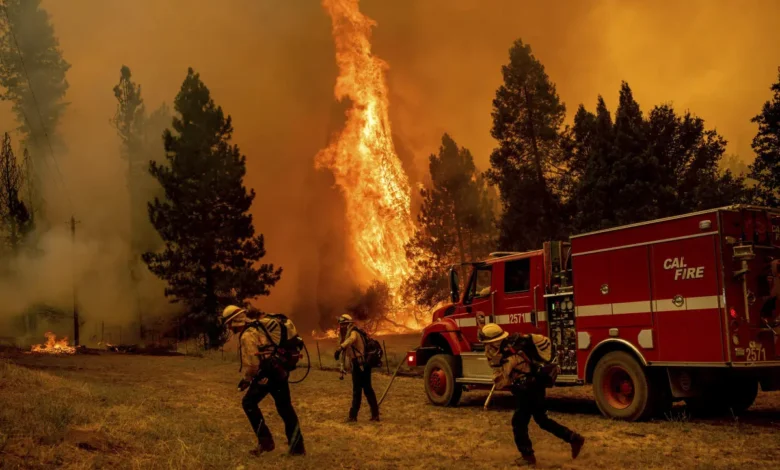Amidst the serene beauty of Mariposa, California, lies the stark reality of wildfire vulnerability at sites such as Idle Wheels Mariposa CA Fire. With the increasing incidences of fires across the state, it’s a crucial reminder of nature’s unpredictable power. Incidents like Idle Wheels spotlight the vital need for strategic planning and resilient infrastructure.
The Idle Wheels Mariposa CA Fire underscores the ever-present threat in wildfire-prone regions. Once a safe haven, it now reflects the pressing need for comprehensive evacuation strategies. As statistics show a 30% increase in fire occurrences, implementing proactive measures like advanced fire detection systems becomes imperative.
The Idle Wheels Mariposa CA Fire significantly impacted the community, highlighting the importance of effective fire management and evacuation strategies. It demonstrated the need for advanced technology in early detection and response, coordinated efforts among agencies, and increased public awareness about wildfire risks to enhance future preparedness and resilience.

Overview of the Idle Wheels Mariposa CA Fire
The Idle Wheels Mariposa CA Fire was a significant event that affected many. It started during a dry and windy season, making it difficult to control. Firefighters worked tirelessly, using all resources available to combat the blaze. The fire raged through the area, affecting homes and wildlife alike. While the damage was extensive, the community’s resilience shone through.
Officials responded quickly to the fire, prioritizing the safety of residents. Evacuation orders were issued to protect people from harm. Emergency response teams collaborated to manage the situation effectively. Throughout the ordeal, communication played a key role. Their swift actions helped minimize potential casualties.
In the wake of the Idle Wheels Mariposa CA Fire, local authorities emphasized fire safety. They educated residents about measures to prevent future disasters. Strategies included maintaining defensible spaces around homes and creating emergency plans. Workshops were held to inform the community. Such efforts aim to foster a culture of preparedness.
Various factors contributed to the intensity of the fire. Among them were high temperatures, low humidity, and favorable winds. A better understanding of these conditions can improve readiness. Using technology to predict fire behavior can also aid prevention efforts. This knowledge is vital in shielding communities from similar events.
Background and Details of the Fire
The Idle Wheels Mariposa CA Fire began on a hot July afternoon. The region was unusually dry, creating ideal conditions for a fast-spreading fire. Investigations suggest that the blaze was sparked by human activity. As the flames grew, firefighters struggled against unpredictable winds. Their battle was complicated by challenging terrain.
Responding to the situation, authorities implemented action plans swiftly. Firefighters from neighboring areas joined in to provide support. Air support with water drops was crucial in containing the flames. Affected residents were evacuated to ensure their safety. Relief centers were set up to accommodate the displaced families.
The fire scorched thousands of acres, leaving a significant mark on the landscape. Animals and plants suffered great losses due to the fire’s intensity. Efforts to rehabilitate the environment began soon after the flames were controlled. Local wildlife organizations played a vital role in recovery efforts. Plans focused on restoring habitats and aiding displaced animals.
Community spirit remained strong during this crisis. Neighbors helped one another, providing shelter and supplies. Volunteers from surrounding communities joined the recovery process. Donations of food, clothing, and essentials poured in. This collective effort helped rebuild hope amid the devastation.
Impact and Aftermath of the Fire
The Idle Wheels Mariposa CA Fire left a significant impact on the community and environment. Many families lost their homes, facing the challenge of rebuilding their lives. Schools and businesses were temporarily closed, affecting daily routines. The economic impact spread throughout the area, with local shops experiencing downturns. Yet, community unity grew stronger during these tough times.
Environmental damage was another major concern, with large areas of forest and wildlife habitat burned. Native plants were destroyed, leading to soil erosion risks. Recovery plans included reforestation efforts to restore the natural landscape. Wildlife groups worked tirelessly to rescue and rehabilitate injured animals. These measures aimed to bring life back to the damaged ecosystems.
Health-related issues emerged post-fire, affecting many residents. Smoke inhalation caused respiratory problems for some individuals. Temporary clinics offered medical services for those in need. Families received information on safety measures to protect against future health risks. This support was crucial for recovery and prevention.
Despite the impacts, the community focused on rebuilding efforts. Volunteers from all over helped clear debris and rebuild structures. Fundraising events provided financial aid to affected families. Various organizations stepped in to offer support and resources. Through these collective efforts, the community moved forward together.
Fire Management and Evacuation Strategies
Effective fire management is crucial in preventing loss during wildfires. Training firefighters with the latest techniques helps prepare them for diverse situations. Advanced technology, like drones, assists in monitoring fire spread. Utilizing weather data, teams can predict fire behavior, enhancing response efforts. This combination of skills and technology is key in fighting fires efficiently.
Ensuring community safety demands comprehensive evacuation plans. Clearly marked evacuation routes guide families to safety swiftly. Authorities conduct regular drills to keep residents well-informed. It’s important for each household to have an emergency grab-bag ready. These steps reduce panic and ensure orderly evacuations.
Communication plays a vital role during emergencies. Authorities use various channels, such as social media and local radio, to relay information. Emergency alerts inform residents of changes in the situation. Accurate, timely updates prevent misinformation and maintain calm. Transparent communication reassures the community during crises.
Coordination between agencies strengthens fire management efforts. Collaboration ensures resources like water and equipment are used effectively. External agencies and volunteers often support local teams during major fires. Joint operations lead to more comprehensive and timely responses. Such partnerships enhance overall readiness to tackle wildfires.
Post-fire analysis helps refine future strategies. Learning from each event provides insights into improving plans. Communities are encouraged to offer feedback based on their experiences. Authorities incorporate this knowledge into training programs. This cycle of evaluation and improvement bolsters preparedness continuously.
Preventive Measures for Future Incidents
Reducing wildfire risk starts with effective land management strategies. Removing dry brush and dead trees lessens fuel for fires. Controlled burns are used to clear these natural accelerants safely. Monitoring vegetation growth helps in planning these preventative measures. Maintaining land health is a proactive way to minimize fire hazards.
Educating the community about fire safety is essential. Homeowners should assess their properties for potential risks. Creating defensible spaces around homes can prevent spreading flames. Practicing home evacuation plans ensures family members know what to do. These actions empower residents to protect their homes and loved ones.
Investing in technology can further enhance prevention efforts. Fire detection systems, like cameras and sensors, provide early warnings. Satellites track conditions conducive to wildfires, helping in vigilant monitoring. This tech allows for prompt responses, reducing potential damage. Utilizing such tools is a modern approach to an age-old problem.
Strengthening cooperation among agencies improves preparedness. Sharing resources and knowledge leads to better outcomes. Cross-training exercises enable teams to handle diverse emergencies. Joint planning facilitates streamlined operations during crisis situations. Together, they form a strong defensive network against future incidents.
Promoting awareness campaigns is key in fostering a safety-first culture. Schools and local groups can host workshops on fire hazards. Distributing information through media amplifies the message. Empowering individuals with knowledge ensures they act responsibly. This widespread awareness builds a more resilient community.
Lessons Learned from the Idle Wheels Fire
The Idle Wheels Mariposa CA Fire highlighted the importance of preparedness in wildfire-prone areas. It taught us that early detection is crucial to minimize damage. Implementing regular fire drills can enhance readiness among residents. The incident also showed the value of efficient communication. Keeping everyone informed is vital during emergencies.
Coordination among response teams proved essential during the fire. Agencies working together ensured swift action and resource allocation. Mutual aid agreements allowed for a more robust response. Sharing information between teams improved decision-making processes. This collaboration is key for future emergency management.
Public awareness about fire risks increased significantly after the event. Educational campaigns emphasized the need for household safety measures. Many residents realized the importance of creating defensible zones around their properties. This awareness is now a part of community culture. Reinforcing these lessons will continue to benefit the region.
The use of technology played a key role in managing the situation. From detecting hotspots to mapping fire spread, technology improved response efficiency. Authorities recognize the need for continuous advancements in these tools. Investing in such technologies can further enhance community safety. Staying ahead with innovation is a lesson well-learned.
Building resilience was another takeaway from the fire. Emotional and psychological support for affected individuals was crucial. Community centers became places of refuge and healing. These experiences underscored the need for robust social support systems. Strengthening these networks can help communities recover more quickly.
Conclusion
The Idle Wheels Mariposa CA Fire served as a sobering reminder of the vulnerabilities faced by fire-prone areas. It emphasized the necessity for strategic planning and community engagement in fostering a resilient environment. The lessons learned continue to shape future approaches to fire management and prevention.
Active collaboration among agencies and the use of modern technology have proven vital in managing such crises. Increasing public awareness equips individuals with knowledge to mitigate risks. Moving forward, these insights will guide efforts to safeguard communities and the natural landscapes they cherish.
FAQ:
What was the Idle Wheels Mariposa CA Fire?
The Idle Wheels Mariposa CA Fire was a significant wildfire incident in Mariposa, California, highlighting the importance of strategic planning, fire management, and community preparedness.
What caused the Idle Wheels Mariposa CA Fire?
Investigations suggest the fire was sparked by human activity, fueled by dry conditions, high temperatures, and favorable winds.
What measures can be taken to prevent similar wildfires?
Preventive measures include maintaining defensible spaces, creating emergency plans, utilizing advanced fire detection systems, and conducting regular fire drills.
How can communities prepare for wildfire emergencies?
Communities can prepare through education, evacuation planning, maintaining emergency supplies, and staying informed about fire risks and safety measures.
What lessons were learned from the Idle Wheels Mariposa CA Fire?
Lessons learned from the Idle Wheels Mariposa CA Fire, include the importance of early detection, efficient communication, agency coordination, public awareness, and investing in technology to enhance community safety and resilience.







